
All Solutions
Section 1-5: Inverse Relations
#### (a)
$left(5,2 right)$
#### (b)
$left(-6,-5 right)$
#### (c)
$left(-8,4 right)$
#### (d)
Here we have that our $textbf{origin point}$ is $left(1,2 right)$, so, the $textbf{inverse point}$ is $left(2,1 right)$.
#### (e)
Here we have that our $textbf{origin point}$ is $left(-3,0 right)$, so, the $textbf{inverse point}$ is $left(0,-3 right)$.
#### (f)
Here we have that our $textbf{origin point}$ is $left(0,7 right)$, so, the $textbf{inverse point}$ is $left(7,0 right)$.
So, according to this, there are following solutions of this task:
#### (a)
$D=Bbb{R}$
$R=Bbb{R}$
#### (b)
$D=Bbb{R}$
$R=left[2,infty right)$
#### (c)
$D=left(-infty,2 right)$
$R=left[-5,infty right)$
#### (d)
$D=left(-5,10 right)$
$R=left(-infty,2 right)$
So, according to this, we have following pairs:
$A-D$, $B-F$, $C-E$
To find this point, first we have to find $f(4)$. So, let’s find it!
$f(4)=2cdot4^3+1=2cdot64+1=128+1=129$
$textbf{The required point is $left(4,129 right)$}$.
#### (b)
$textbf{The ordered pair on the inverse relation that corresponds to
the ordered pair $left(4,129 right)$ is point $left(129,4 right)$}$
The explanation is in the task number 1.
#### (c)
$textbf{The doamin and range of $f$ is state $Bbb{R}$}$.
#### (d)
According to explanation in task number 2, $textbf{(the daomain and range of inverse function is also state $Bbb{R}$}$.
#### (e)
$textbf{The inverse relation is a function}$, we can see that by forming table of values, switching the independent and dependent variables in
the table of values.
To find this point, first we have to find $f(4)$. So, let’s find it!
$f(4)=4^4-8=256-8=248$
$textbf{The required point is $left(4,248 right)$}$.
#### (b)
$textbf{The ordered pair on the inverse relation that corresponds to
the ordered pair $left(4,248 right)$ is point $left(248,4 right)$}$
The explanation is in the task number 1.
#### (c)
$textbf{The doamin and range of $f$ are}$:
$D=Bbb{R}$
$R=left[-8,infty right)$
#### (d)
According to explanation in task number 2, $textbf{the domain and range of inverse function are}$:
$D=left[-8,infty right)$
$R=Bbb{R}$
Let’s first find $textbf{inverse relation:}$
$y=x^4-8$
$x=y^4-8$
$y^4=x+8$
$y=sqrt[4]{x+8}$ $wedge$ $y=-sqrt[4]{x+8}$
Here, $textbf{the inverse relation is not a
function}$, but it can be split in
the middle into the two
functions.
Let’s first find $textbf{inverse relation}$:
$y=x^2+1$
$x=y^2+1$
$y^2=x-1$
$y=-sqrt{x-1}$ $wedge$ $y=sqrt{x-1}$
$textbf{This inverse relation is not a function}$, but it can be split on two functions. On the following graph red one is graph of $y=x^2+1$, blue one is of $y=-sqrt{x-1}$ and green one is of $y=sqrt{x-1}$:
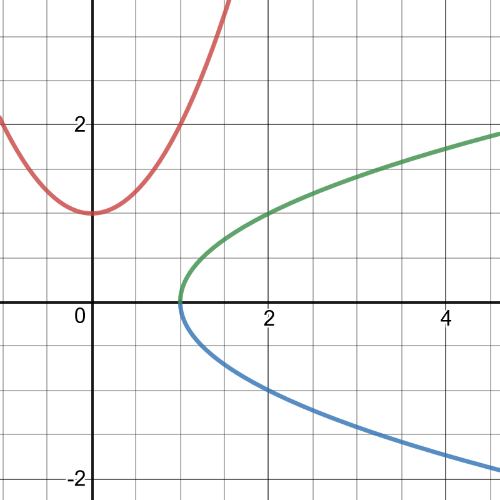
Let’s first find $textbf{inverse relation}$. $textbf{Inverse relation of this function on this domain is also function and it is function}$ $y=arcsin{x}$
On the following graph, red one is graph ofthe function $y=sin{x}$ and purple one is of inverse function, $y=arcsin{x}$:
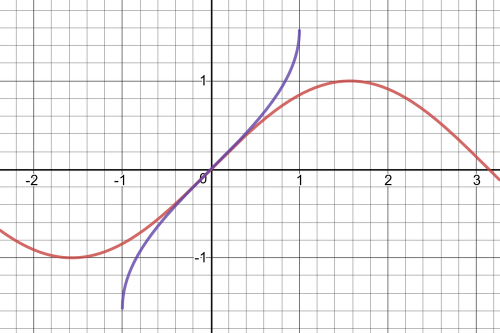
Here, we have:
$y=-x$
$x=-y$
$y=-x$
We can see that $textbf{inverse relation is actually origin function}$, and according to this, it is function. So, the graph of origin and inverse function will bw the graph of the same function, $y=-x$, which follows:
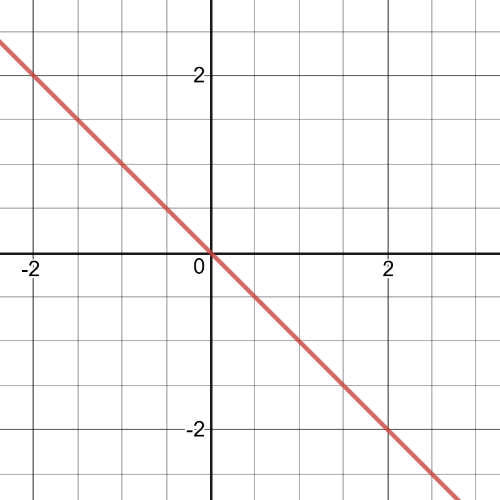
Let’s first find inverse relation:
$y=left|x right|+1$
$x=left|y right|+1$
$left|y right|=x-1$
According to the definition of absolute value, here we have two functions, and also, according to this, we conclude that this $textbf{inverse relation is not a function}$:
$y=x-1$ $wedge$ $y=-(x-1)$
On the following graph, red one is graph of the $y=left|x right|+1$, black one is of $y=x-1$ and green one is of $y=-(x-1)$:
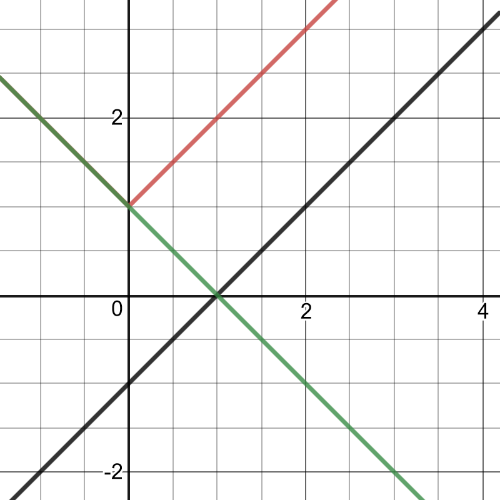
Let’s first find $textbf{inverse relation}$:
$F=dfrac{9}{5}C+32$
$dfrac{9}{5}C=F-32$
$9C=5(F-32)$
$C=dfrac{5}{9}(F-32)$
$textbf{This equation convert Fahrenheit temperature to the equivalent Celsius temperature}$.
#### (b)
First, we will find equiavlent Fahrenheit temperature to 20°C. For this, we will use $textbf{origin relation}$, and we get:
$F=dfrac{9}{5}cdot20+32=9cdot4+32=36+32=68$
So,the answer is $68F$.
To find equivalent Celsius temperature to $68F$, we will use $textbf{transformed relation}$:
$C=dfrac{5}{9}cdotleft(68-32 right)=dfrac{5}{9}cdot36=5cdot4=20$
So,the result is $20°C$.
Let’s first find the $textbf{inverse relation}$:
$A=picdot{r^2}$
$r^2=dfrac{A}{pi}$
$r=sqrt{dfrac{A}{pi}}$
This inverse of the relation we use for $textbf{finding the radius when the area of the circle is known}$.
#### (b)
Because we know that the radius is $r=5$ and do not know the area of the circle, $textbf{we will use origin relation}$:
$A=picdot{r^2}=picdot5^2=25cdotpi$
So, the area of the circle is $A=25pi$
Now, if we know that the area of the circle is $A=25pi$, we will find the radius using $textbf{inverse of the relation}$:
$r=sqrt{dfrac{A}{pi}}=sqrt{dfrac{25pi}{pi}}=sqrt{25}=5$
So, the radius is $r=5$
$y=kx^3+1$
$x=ky^3+1$
$ky^3=x-1$
$y^3=dfrac{x-1}{k}$
$y=sqrt[3]{dfrac{x-1}{k}}=f^{-1}(x)$
We are given in task that $f^{-1}(15)=2$, we have that:
$2=sqrt[3]{dfrac{15+1}{k}}$
$2^3=dfrac{16}{k}$
$8=dfrac{16}{k}$
$k=dfrac{16}{8}=2$
So,the final result is that $k=2$
$h(3)=2cdot3+7=6+7=13$
#### (b)
$h(9)=2cdot9+=18+7=25$
#### (c)
Here, we will use results from $left( aright)$ and $left( bright)$:
$dfrac{h(9)-h(3)}{9-3}=dfrac{25-13}{6}=dfrac{12}{6}=2$
Now, let’s find first $textbf{inverse relation}$:
$y=2x+7$
$x=2y+7$
$2y=x-7$
$y=dfrac{x-7}{2}=h^{-1}(x)$
#### (d)
$h^{-1}(3)=dfrac{3-7}{2}=-dfrac{4}{2}=2$
#### (e)
$h^{-1}(9)=dfrac{9-7}{2}=-dfrac{2}{2}=1$
Here, we will use results from $left(d right)$ and $left(e right)$:
$dfrac{h^{-1}(9)-h^{-1}(3)}{9-3}=dfrac{1+2}{6}=dfrac{1}{2}$
#### (a)
$y=3x+4$
$x=3y+4$
$3y=x-4$
$color{#c34632}{y=dfrac{x-4}{3}}$
#### (b)
$y=-x$
$x=-y$
$color{#c34632}{y=-x}$
#### (c)
$y=x^3-1$
$x=y^3-1$
$y^3=x+1$
$color{#c34632}{y=sqrt[3]{x+1}}$
$y=-2(x+5)=-2x-10$
$x=-2y-10$
$-2y=x+10$
$color{#c34632}{y=-dfrac{x+10}{2}}$
We will find $textbf{an equation for inverserelation}$ of this function:
$y=4(x-3)^2+1$
$x=4(y-3)^2+1$
$4(y-3)^2=x-1$
$(y-3)^2=dfrac{x-1}{4}$
$y-3=pmsqrt{dfrac{x-1}{4}}$
$color{#c34632}{y=pmsqrt{dfrac{x-1}{4}}+3}$
#### (b)
$textbf{Solve for $y$}$ in the equation for the inverse $g$ are:
$y=-sqrt{dfrac{x-1}{4}}$ $vee$ $y=sqrt{dfrac{x-1}{4}}$
#### (c)
Here we have graphs of function $g$ and of its inverse relaation from $left(b right)$. Red one is graph of $g$, blue one is of $y=-sqrt{dfrac{x-1}{4}}$, and green one is of $y=sqrt{dfrac{x-1}{4}}$:
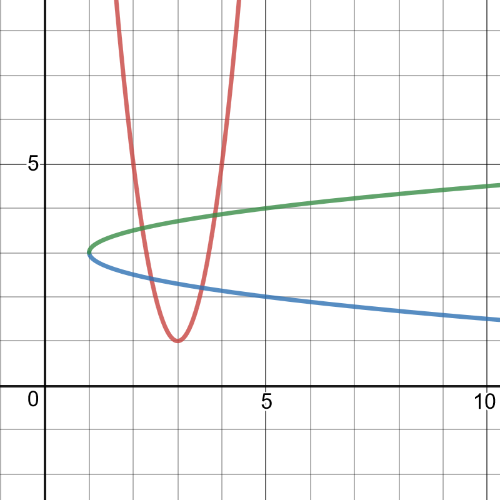
Cross points of the function $g$ and $y=-sqrt{dfrac{x-1}{4}}$,as we can see from the graph are:
$left(2.407,2.407 right)$ $wedge$ $left(3.548,2.202 right)$
Cross points of the function $g$ and $y=sqrt{dfrac{x-1}{4}}$,as we can see from the graph are:
$left(2.202,3.548 right)$ $wedge$ $left(3.843,3.843 right)$
#### (e)
$textbf{We should make restriction od domain}$, then, inverse relation will be a function. This restriction might be any of two following states or any of their subsets:
$D=left(-infty,3 right]$ or $D=left[3,infty right)$
#### (f)
On this domain, $textbf{inverse relation is not a function}$ because only with restrictions on the domain like in $left(e right)$ inverse will be a function.
$x=y^2-2$
$y^2=x+2$
$color{#c34632}{y=pmsqrt{x+2}}$
In order for $y$ to be inverse, its inverse must be the starting function. But here inverse of inverse function does not exist, it can only be split into two functions, and one of them is $y=-sqrt{x+2}$, but this does not mean that it is an inverse function.
:
$x=sqrt{y+2}$
$x^2=y+2$
$color{#c34632}{y=x^2-2}$
$textbf{Its inverse is a function}$, we should not make a restriction either on a domain or on a range. The simplest way is to see this with the graphics of exactly this inverse function because the test of vertical lines passes.
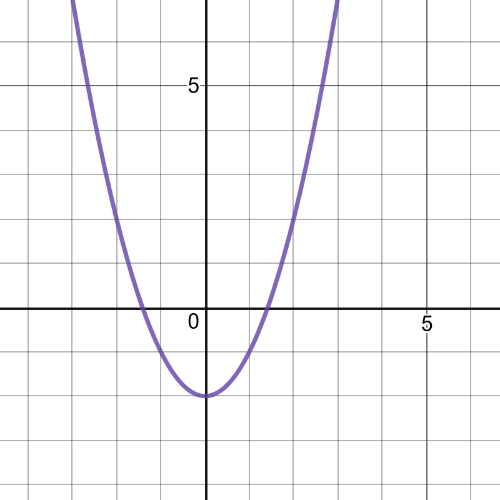
Now, $textbf{we will find its inverse step by step}$:
$x=dfrac{y^3}{4}+2$
$x-2=dfrac{y^3}{4}$
$4(x-2)=y^3$
$color{#c34632}{y=sqrt[3]{4(x-2)}}$
So, the answer is John was correct!
Here we have graphs of those functions, blue one is of $y=dfrac{x^3}{4}+2$ and red one is graph of inverse:
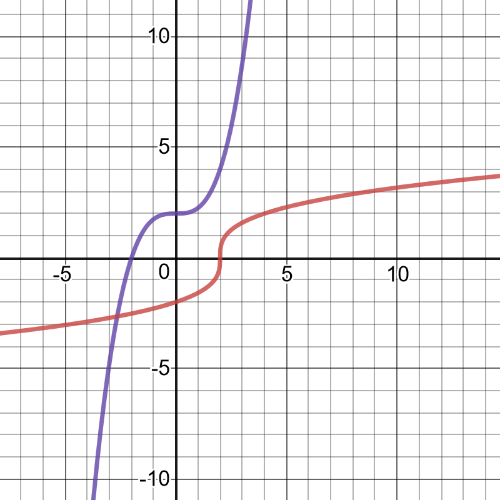
$f(x)=-x$
$f(x)=left|x right|$
$f(x)=-left|x right|$
And no, $textbf{we can’t convince ourselves}$ that there are an infinite number of functions that satisfy property given in this task.

